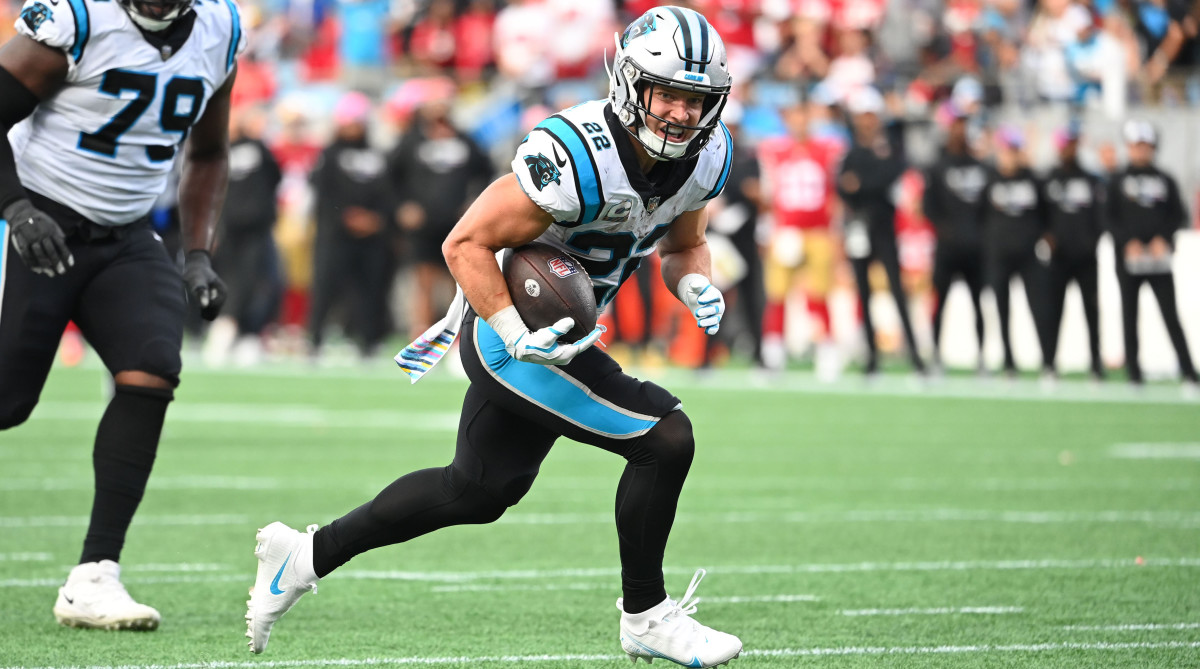Christian McCaffrey Is a Perfect Fit for What the 49ers Already Do Well
[Editor’s Note: This story was originally published on Oct. 21, 2022, when McCaffrey was traded to San Francisco.]
There was only one fictional (before Thursday night, anyway) dream scenario where the hardened football cynic in all of us could have been roused by the idea of a running back trade before the deadline. In our wildest imagination, if a team could manage to pry Christian McCaffrey from the Panthers’ fire sale and place him into the capable arms of the best-designed and most potentially dangerous running game on planet earth (the 49ers), we’d allow our jaws to hit the floor.
Most of the football world awoke Friday—those who didn’t make it to the end of Thursday Night Football, at least—to learn that was no longer a dream. And most NFL teams not in Santa Clara might have called it a nightmare.

This is not hyperbole, even if it may sound like it: The 49ers’ grabbing McCaffrey, as first reported by ESPN, for second-, third- and fourth-round picks in 2023 and a fifth-rounder in 2024, is a move that absolutely and undeniably changes the balance of power in a sleepy NFC. It potentially vaults San Francisco’s offense into an elite stratosphere, even if it’s currently piloted by Jimmy Garoppolo, a quarterback whom they would not have preferred to have under center at the moment and even if their rushing efficiency numbers are currently pedestrian.
It is a trade that could win them the division (the Rams were, reportedly, in on McCaffrey as well) and one that could vault them deep into the playoffs should McCaffrey remain healthy. Despite the incredibly steep price for a 26-year-old running back who has played 16 games since the start of 2020, it was a move that uniquely fits the 49ers’ personality and could help them overcome their limitations elsewhere.
While we have been teased by the Kyle Shanahan regime before—was anyone else convinced Trey Lance would have already changed the way we view football by now—the move to grab McCaffrey is a doubling down on what the 49ers already have the capability of doing better than any team in the NFL.
Ask around the league, and there were points in previous seasons when the 49ers’ rendition of the outside-zone running game was so fine-tuned that most of the offensive linemen were placed in positions of power before the snap and could throw advantageous, downhill blocks at nearly every position. They were—and still are—better equipped to win at the snap than any offensive line in the NFL. This is a unit that has already shown itself capable of making stars out of Raheem Mostert, Matt Brieda, Jeff Wilson Jr. and Elijah Mitchell.
To put it another way: If a standard run game had the intricacies of a typical wristwatch, San Francisco’s has the inner-workings of a Richard Mille.
Now, it adds a running back who was averaging nearly a career high per carry (4.6 yards) within one of the worst offenses in football this year in Carolina. McCaffrey, whose father, Ed, was a wide receiver in Mike Shanahan’s Super Bowl–winning outside-zone offense for the Broncos, seems to have been placed on earth to run in this offense, which allows a running back to make a vicious upfield cut on the way to a target point, whenever the right alley may develop.
From a practical standpoint, the 49ers have created most of their success over the past few years by dictating the personnel a defense needs to have on the field, and then running plays that directly attack its soft spots. As we’ve written before, and as former Shanahan quarterback Robert Griffin III wisely pointed out after the trade on Thursday, they have Kyle Juszczyk, a fullback (in theory) who forces defenses into their base formation. They have George Kittle, a tight end (in theory) who can abuse the extra linebacker on the field needed for base defenses with his expert route-running ability. Or, he can dominate in the run game as an elite-level blocker if defenses keep an extra defensive back on the field.
Last year, Shanahan added Deebo Samuel into his magicians’ trunk. The All-Pro wide receiver carried the ball 59 times at more than six yards per clip, but also saw 121 targets in the passing game, amassing more than 1,400 receiving yards. Now, McCaffrey will serve as an inverse of Samuel, a talented runner who will be useful in the passing game, and take advantage of some of the friendliest mismatches he has enjoyed since Stanford hosted Rice during McCaffrey’s final season in college.
Defensive coordinators who would use certain personnel groupings as anchors in a storm now have zero reference points for where to start with this offense. The 49ers could line up the same group of skill-position players and effectively mimic a half-dozen different combinations.
This is why the move is, ultimately, so exciting, and why it has awoken the schematic fanboy in all of us. It’s fair to argue that Samuel would not have been Deebo Samuel had he not been drafted by the 49ers. It’s fair to say the same about Kittle. Even before Thursday, we would have labeled the 49ers as having one of the best groupings of running backs, tight ends and wide receivers in the NFL, simply by virtue of how they have been used. We could also be fairly certain that they would not have been deployed the same way anywhere else in the NFL (now that Shanahan’s longtime running-game guru Mike McDaniel is in Miami, we can probably add the Dolphins to this list).
Imagine now saying that about McCaffrey, a player who, over his first three years in the NFL, logged almost 40 combined rushing and receiving touchdowns. It may not be dreaming big.
More NFL Coverage:
